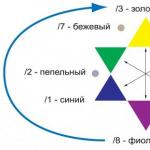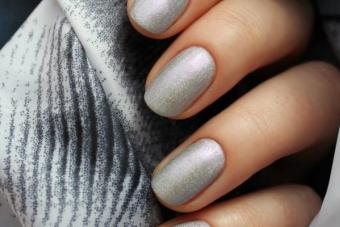MUNICIPAL BUDGETARY PRESCHOOL EDUCATIONAL INSTITUTION
"KINDERGARTEN "KOLOBOK" S. PEROVO" SIMFEROPOL DISTRICT
REPUBLIC OF CRIMEA
Consultation for parents
Subject: "Usage natural material in children's games and crafts"
Prepared by the teacher
Senior group "Golden Fish"
Kononova Tatyana Vitalievna
2017
Crafts from natural material Children especially love them, because they can be created from what they themselves find in the park, in the field, in the forest, on the sea coast or in the mountains. The main thing is to have enough imagination to turn shells, pebbles, pebbles, twigs, dry fruits, cones, acorns, chestnuts, nuts, seeds or inflorescences with your own hands into something extraordinary! In addition, natural material is the most environmentally friendly material for activities with children.
Making crafts from natural materials develops skills:
Fine motor skills;
Teaches you to set a goal and visualize it throughout creative process;
Experiment and look for optimal ways to move towards the goal;
Develops spatial imagination;
Teaches you to see a whole thing in disparate elements;
Develops attention and accuracy, patience and diligence;
Arouses interest in creative design
Introduces a feeling of inspiration;
Teaches to take care of nature;
Little secrets.

Three-dimensional figures can move in space in different ways: vertically, horizontally or obliquely. This or that angle determines the image of the future craft. Even individual parts or details of the image take on a new look depending on their location. So, the head can be attached to the body from above, to the side or below and attached directly to the body or to the neck, which is made from a stick, a cocktail tube, a twig, or a wire.
Berries are flowers.
There are a great many flowers in the world, and all of themgood in their own way. Let's think about a flower - real or fakemagical - and we will select the appropriate material for the petals: maple or ash lionfish, feathers, colored leaves, flat shells, pumpkin seeds, fish scales or lemon peel. Let's connect the petalsinto a lush corolla, to do this we stick them into a piece of plasticine or a fresh acorn. The middle of the flowerIt could be a pine cone, a nut, a piece of tree bark, or a slice of corn cob.
Petals feathers and shells can be painted. Or you can make a flower completely differently: cut the peel of an orange or lemon in the form of a spiral and twist a rose from it silt and a swimsuit. From these flowers you can make a bouquet for a real vase or makeь three-dimensional picture - appliqué composition.


Bugs are spiders.
Shells are good for the body of bugs and spiders. walnut, pebble, chestnut, shell, acorn, piece of bark. We will attach a head from a berry or an acorn cap, legs and antennae from twigs or sticks. Small details are sometimes very important. They tell us which one we have: a stag beetle or a rhinoceros beetle. We will attach 8 legs to the spider and weave a web from blades of grass or threads. For a caterpillar, the easiest way is to take a twig, stick, root, or pea pod.
The birds are small.
It all depends on what kind of bird we have in mind - large or small, bright or inconspicuous. We make a body from a cone, acorn, nut, chestnut, potato. We will make wings from feathers, lionfish, shells, beautiful leaves or blades of grass. Let's make a head from a berry or an acorn. We will attach the head directly to the body or make a neck. Let's figure out what our bird is doing - sitting on a branch and chirping or flying. Depending on this, we’ll come up with a composition: a hummingbird drinks nectar from a flower, a chicken drags a worm from the ground, a parrot gets ruffled and screams. Or you can even make a fire-bird.

Animals.
How to show that a bear is big and fat? The most suitable material for the body is a pine cone, potato, orange, stone. What is our bear doing: lying, sitting, or wandering through the forest? Let's think together! What is the most characteristic thing about a hedgehog? Well, of course, needles. What natural material can show this? But it would be even more interesting to choose a material that is not so traditional as chestnut, but textured, such as part of a hulled ear of corn or thistle.


Trees and bushes.
Well, what is a forest without trees? We will make the crowns of deciduous trees from bunches of leaves and blades of grass, colored feathers. Trunks are made of twigs, sticks, reeds, tubes, cones. Coniferous trees will come out wonderfully from cones. Well and magic trees can be made from anything.
Attention! If the images are interesting, original and arise easily, it means that the child is able to see the material both as it is now in its natural form and as it can become as a result of creativity. If a child notices how the natural form can be changed - remove the excess (break off, tear off) or, conversely, add what is missing(glue, screw), he can easily choose the method of creating crafts.


Fantasies from leaves
Fantasies made from leaves are a fireworks display of creativity! Still would! After all, the color palette is like in painting, but it was given in the leaves initially. Images and compositions are like design, but arise from ready-made forms easily, quickly and in a new way every time. It is convenient to pick up and turn over the leaves with tweezers. The glue is applied in small dots along the edge of the leaf. Simple compositions can be placed directly on the background and glued detail by detail. It is better to first compose complex compositions on a separate sheet of paper, and then transfer them in parts and paste them onto the background, starting from the background and gradually moving to the foreground. You can make patterns, letters, numbers, symbols and even portraits from leaves. The finished painting should be covered with a napkin or any soft, loose paper and kept under load for 10-20 minutes.


Trees look into the water.
Autumn (and summer) arrangements are unusually beautiful with their colors, so it’s always interesting to play with reflections. Let's bring some beautiful twigs from our walk. Let's take a round mirror or oval shape, small vases, tray or plate. We place the mirror on a tray, mask the edges with moss, pebbles or leaves - and we will have a lake. To the side - on the shore of the lake we will place a vase with twigs. These are trees that are reflected in the water.
And in conclusion, I would like to say that working and playing with natural materials brings the child closer to nature, fosters a careful, caring attitude towards it, and develops the first work skills.
The child is the creator of beauty. And everything he creates must find practical application (as gifts, table theater)
Currently, there is a need to take care of strengthening the child’s connection with nature and culture, work and art. Nowadays, children are moving further and further away from nature, forgetting its beauty and value. Working with natural materials helps develop imagination, a sense of shape and color, accuracy, hard work, and instills a love of beauty.
Download:
Preview:
Consultation for parents
CRAFTS FROM NATURAL MATERIAL
Making crafts from natural materials is a fascinating activity. It develops interest and love for nature, respect for it, artistic taste, creative imagination and design abilities, dexterity, ingenuity, hard work, perseverance and patience. Working with natural material, the child becomes familiar with its properties, develops fine motor skills, coordination of movements, etc.
Organize walks and excursions more often, during which you not only observe, but also collect natural material. Learn to collect material in such a way as not to cause damage to nature: birch bark and bark are carefully removed from fallen trees, twigs - dry, cones, seeds, leaves.
Crafts made from natural materials allow us to travel to Magic world nature.
The best time to collect material for natural crafts is summer and autumn.
Don’t pass by and be sure to take for work: leaves and flowers, you can use them to make beautiful crafts, good crafts are obtained from acorns with cups, cones, nuts, beans, beans, peas, fruits, vegetables, twigs are suitable for crafts, you can make natural crafts from sea and river shells, lionfish seeds and much more. Very beautiful crafts can also be made from simple pebbles. Wonderful crafts can be made from natural clay and even sand!
When making crafts, additional materials are also used: paper, cardboard, plasticine, wire, glue, etc.
Do not color natural material, our task is to teach children to highlight it natural beauty. It is much better to cover crafts with colorless varnish to make them more durable and beautiful;
Do not use other materials when decorating, such as paper, foam rubber, polystyrene foam, etc. This makes the craft lose its natural charm;
Do not use material that can cause injury to a child or threaten his health (burdock, poisonous plants, etc.).
It is necessary to encourage children’s desire to collect and use in their works natural material not only from Central Russia, but also from the southern regions of our country: seashells, dogwood seeds, dates, white acacia seeds, cones of southern conifers and other gifts of the south.
Everything a child creates must have a practical application. This is how children use their crafts as gifts, in various games, decorate play corners with them.
Making crafts from natural materials is a fascinating activity. It develops interest and love for nature, respect for it, artistic taste, creative imagination and design abilities, dexterity, ingenuity, hard work, perseverance and patience. Working with natural material, the child gets acquainted with its properties, he develops fine muscles of the hands and coordination of movements, which is very important for correcting speech and preparing the child for educational activities, for a successful step in entering school. Making crafts from natural materials satisfies children's curiosity. In search of something new, children show interest in creativity, design, and achieve their goals. Such work has a beneficial effect on their emotional mood. DIY crafts allow everyone to show their imagination and ingenuity, lift children’s spirits, and help adults get rid of accumulated fatigue. And all thanks to the amazing property of natural materials to charge with energy and remove accumulated negativity.
Consultation for parents:
Crafts made from natural materials
Educator: Pshichenko
Svetlana
Victorovna
Children especially love crafts made from natural materials, because they can be created from what they themselves find in the park, in the field, in the forest, on the sea coast or in the mountains. The main thing is to have enough imagination to turn shells, pebbles, pebbles, twigs, dry fruits, cones, acorns, chestnuts, nuts, seeds or inflorescences with your own hands into something extraordinary! In addition, natural material is the most environmentally friendly material for activities with children.
Making crafts from natural materials develops skills:
Snails
Collect the shells you like, rinse with running water and dry in the sun. Sort the prepared shells by color and shape.
Wash the shells collected on the beach thoroughly in running water and dry in the sun. You can cover the shells with transparent varnish - they will shine like in water.
Select several spirally twisted shells. Take plasticine and sculpt a snail figurine: head, horns, tail. Attach the shell to the snail's back.
Bright pebbles
Children love to collect sea stones on the beach. A brush and paints will turn a smooth pebble into a bug, ladybug, turtle, owl or fungus. The very shape of the pebble will tell the baby which image is best to create. Paint is applied to the pebble - and the image is ready. The pebbles are glued together with plasticine. After the creation has dried, coat it with clear varnish to add shine.
Funny little animals
With a small child, try to do something very simple: for example, make animal figures from tenacious burdock. To do this, make a wool frame in advance on which the burdock will be molded. Then invite the baby to form a teddy bear, an elephant with a long trunk, a dog or a spider.
Amazing picture
This amazing picture can be made from pebbles, small pebbles, shells or cereals (beans, peas). First decide what colors will suit plasticine background for your work. Apply plasticine to the cardboard base. Mark the design on plasticine. Now, together with your baby, carefully fill the drawing with the selected material along the contour.
Picture of leaves
Collect with your child while walking in the park or forest, collect a lot of leaves of different shades and shapes, large and small. Dry them between sheets old book or newspapers, putting something heavy on top. For work you will need sheets of cardboard, glue and natural material. If you are making applications with a small child (1.5-3 years), then you can simply lay out the leaves beautifully on cardboard. Older children can show their imagination and make an amazing applique with your help. The theme of the application can be different birds, animals, fish, cars or even plot pictures.
Crafts from acorns
Acorns come in different varieties: large and small, oblong and round. In a donkey or horse, the body is made from a large acorn, and the head from a small one. Also, from two acorns - a smaller one and a larger one - and several sticks you can make a beautiful stork. You can make funny people: thin and fat, tall and short, wearing hats. The main thing is that everything must be done while the acorns have not yet dried. Toys made from fresh acorns last a long time.
And how many funny and nice figures can be made from chestnuts, cones and nuts! Simply countless, especially if your imagination plays out during work.
Flower Elves
For this craft you will need some flowers. Collect them with your child during your walk in the park or forest. To make an amazing picture you will need: cardboard, pencils or markers, glue, flowers and petals. First draw the shapes on the cardboard, and then start gluing the clothes, wings and magic wand.
A few more tips:
In order for the child to understand the sequence of work, you must first show how to make the craft. After the baby has learned the first basics of creating a toy from natural material, it will be enough for him to show a drawing, picture or photograph finished crafts, and with an understanding of the process he will be able to make it himself. Then the child should be asked to make something from natural material. fairy tale characters or seeing animals at the zoo. Such activities significantly develop children's creativity, fantasy and imagination.
Pshichenko Svetlana Viktorovna
Consultation for parents:
Educator: Pshichenko
Svetlana
Victorovna
- develops fine motor skills;
- teaches you to set a goal and visualize it throughout the creative process;
- experiment and look for optimal ways to move towards the goal;
- develops spatial imagination;
- teaches you to see a whole thing in disparate elements;
- develops attention and accuracy, patience and diligence;
- awakens interest in creative design
- introduces a feeling of inspiration;
- teaches you to take care of nature.
Snails
Collect the shells you like, rinse with running water and dry in the sun. Sort the prepared shells by color and shape.
Wash the shells collected on the beach thoroughly in running water and dry in the sun. You can cover the shells with transparent varnish - they will shine like in water.
Select several spirally twisted shells. Take plasticine and sculpt a snail figurine: head, horns, tail. Attach the shell to the snail's back.
Bright pebbles
Children love to collect sea stones on the beach. A brush and paints will turn a smooth pebble into a bug, ladybug, turtle, owl or fungus. The very shape of the pebble will tell the baby which image is best to create. Paint is applied to the pebble - and the image is ready. The pebbles are glued together with plasticine. After the creation has dried, coat it with clear varnish to add shine.
Funny little animals
With a small child, try to do something very simple: for example, make animal figures from tenacious burdock. To do this, make a wool frame in advance on which the burdock will be molded. Then invite the baby to form a teddy bear, an elephant with a long trunk, a dog or a spider.
Amazing picture
This amazing picture can be made from pebbles, small pebbles, shells or cereals (beans, peas). First, decide what color plasticine background is suitable for your work. Apply plasticine to the cardboard base. Mark the design on plasticine. Now, together with your baby, carefully fill the drawing with the selected material along the contour.
Picture of leaves
Collect with your child while walking in the park or forest, collect a lot of leaves of different shades and shapes, large and small. Dry them between sheets of an old book or newspaper, placing something heavy on top. For work you will need sheets of cardboard, glue and natural material. If you are making applications with a small child (1.5-3 years), then you can simply lay out the leaves beautifully on cardboard. Older children can show their imagination and make an amazing applique with your help. The theme of the application can be different birds, animals, fish, cars or even plot pictures.
Crafts from acorns
Acorns come in different varieties: large and small, oblong and round. In a donkey or horse, the body is made from a large acorn, and the head from a small one. Also, from two acorns - a smaller one and a larger one - and several sticks you can make a beautiful stork. You can make funny people: thin and fat, tall and short, wearing hats. The main thing is that everything must be done while the acorns have not yet dried. Toys made from fresh acorns last a long time.
And how many funny and nice figures can be made from chestnuts, cones and nuts! Simply countless, especially if your imagination plays out during work.
Flower Elves
For this craft you will need some flowers. Collect them with your child during your walk in the park or forest. To make an amazing picture you will need: cardboard, pencils or markers, glue, flowers and petals. First draw the shapes on the cardboard, and then start gluing the clothes, wings and magic wand.
A few more tips:
- For panels, paintings, toys made from natural materials you will need cones, seeds of various plants, acorns, catkins of alder, birch, acacia, fruits of various plants, leaves, roots, flowers, shells.
- Frames covered with cereals (buckwheat, semolina, corn, millet, sunflower seeds) or shells look amazing - for paintings, photos or mirrors, as well as wooden boxes.
Download:
Preview:
Consultation for parents:
Crafts made from natural materials
Educator: Pshichenko
Svetlana
Victorovna
Children especially love crafts made from natural materials, because they can be created from what they themselves find in the park, in the field, in the forest, on the sea coast or in the mountains. The main thing is to have enough imagination to turn shells, pebbles, pebbles, twigs, dry fruits, cones, acorns, chestnuts, nuts, seeds or inflorescences with your own hands into something extraordinary! In addition, natural material is the most environmentally friendly material for activities with children.
Making crafts from natural materials develops skills:
- develops fine motor skills;
- teaches you to set a goal and visualize it throughout the creative process;
- experiment and look for optimal ways to move towards the goal;
- develops spatial imagination;
- teaches you to see a whole thing in disparate elements;
- develops attention and accuracy, patience and diligence;
- awakens interest in creative design
- introduces a feeling of inspiration;
- teaches you to take care of nature.
Snails
Collect the shells you like, rinse with running water and dry in the sun. Sort the prepared shells by color and shape.
Wash the shells collected on the beach thoroughly in running water and dry in the sun. You can cover the shells with transparent varnish - they will shine like in water.
Select several spirally twisted shells. Take plasticine and sculpt a snail figurine: head, horns, tail. Attach the shell to the snail's back.
Bright pebbles
Children love to collect sea stones on the beach. A brush and paints will turn a smooth pebble into a bug, ladybug, turtle, owl or fungus. The very shape of the pebble will tell the baby which image is best to create. Paint is applied to the pebble - and the image is ready. The pebbles are glued together with plasticine. After the creation has dried, coat it with clear varnish to add shine.
Funny little animals
With a small child, try to do something very simple: for example, make animal figures from tenacious burdock. To do this, make a wool frame in advance on which the burdock will be molded. Then invite the baby to form a teddy bear, an elephant with a long trunk, a dog or a spider.
Amazing picture
This amazing picture can be made from pebbles, small pebbles, shells or cereals (beans, peas). First, decide what color plasticine background is suitable for your work. Apply plasticine to the cardboard base. Mark the design on plasticine. Now, together with your baby, carefully fill the drawing with the selected material along the contour.
Picture of leaves
Collect with your child while walking in the park or forest, collect a lot of leaves of different shades and shapes, large and small. Dry them between sheets of an old book or newspaper, placing something heavy on top. For work you will need sheets of cardboard, glue and natural material. If you are making applications with a small child (1.5-3 years), then you can simply lay out the leaves beautifully on cardboard. Older children can show their imagination and make an amazing applique with your help. The theme of the application can be different birds, animals, fish, cars or even plot pictures.
Crafts from acorns
Acorns come in different varieties: large and small, oblong and round. In a donkey or horse, the body is made from a large acorn, and the head from a small one. Also, from two acorns - a smaller one and a larger one - and several sticks you can make a beautiful stork. You can make funny people: thin and fat, tall and short, wearing hats. The main thing is everythingmust be done while the acorns have not yet dried. Toys made from fresh acorns last a long time.
And how many funny and nice figures can be made from chestnuts, cones and nuts! Simply countless, especially if your imagination plays out during work.
Flower Elves
For this craft you will need some flowers. Collect them with your child during your walk in the park or forest. To make an amazing picture you will need: cardboard, pencils or markers, glue, flowers and petals. First draw the shapes on the cardboard, and then start gluing the clothes, wings and magic wand.
A few more tips:
- For panels, paintings, toys made from natural materials you will need cones, seeds of various plants, acorns, catkins of alder, birch, acacia, fruits of various plants, leaves, roots, flowers, shells.
- Frames covered with cereals (buckwheat, semolina, corn, millet, sunflower seeds) or shells look amazing - for paintings, photos or mirrors, as well as wooden boxes.
In order for the child to understand the sequence of work, you must first show how to make the craft. After the child has learned the first basics of creating a toy from natural material, it will be enough for him to show a drawing, picture or photograph of the finished craft, and he will be able to make it himself with an understanding of the process. Then the child should be asked to make fairy-tale characters or animals seen in the zoo out of natural material. Such activities significantly develop children's creativity, fantasy and imagination.
Consultation for parents: “Arrangements from natural and waste materials”
On the importance of manual labor for the comprehensive development of children.
In the process of working with natural materials, a caring attitude towards nature is formed, and the first labor skills are developed.
Children's encounters with nature expand their understanding of the world around them.
In the process of systematic manual labor, the child’s hands acquire confidence, accuracy, and fingers become flexible, which is important for his preparation for school.
Manual labor promotes the development of sensorimotor skills, coordination in the work of the eyes and hands, the development of attention and increasing its stability, and helps the formation of voluntary attention.
Making crafts from natural materials satisfies children's curiosity. In search of something new, children show interest in creativity, design, and achieve their goals. Such work has a beneficial effect on their emotional mood.
In the process of manual labor, a child’s character is formed: making crafts requires strong-willed efforts. Under the guidance of an adult, he tries to eliminate difficulties, he develops such qualities as self-control and self-esteem.
Natural material that can be used when working with children.
Material: cones, nuts, pine needles, chestnuts, acorns, birch bark, branches, leaves, seeds, rose hips, rowan, straw, moss, feathers, shells.
Additional materials: paper, foil, plasticine, wire, thread, colored scraps, pebbles, plywood.
The best works will be used for the subject-development environment of the group room. To decorate rooms in winter time You can select, first of all, branches of ornamental shrubs with brightly colored fruits (rose hips, hawthorn) and beautifully curved ones with a bizarre silhouette (linden, oak, apple tree branches). The leaves of maple and aspen look very colorful, the dried shoots with inflorescences of cereals and lilies, especially their umbrellas, are spectacular; sometimes reaching large sizes.
Arrangements from dry leaves and rules for their composition.
When composing compositions of dried flowers, you need to remember proportionality: a huge bouquet in a huge vase is out of place in a small room. For a lush bouquet, it is better to choose a simple vase, strict in shape and color. More modest plants are placed in the middle, highlighting its beauty. For a dark room, choose light and bright plants. Dried flowers and inflorescences can be lightly tinted with watercolor or gouache paints.
Quality winter bouquets and compositions depends on when they are collected required material. It is very important for a plant to find the moment when it is most decorative and best suited for processing. Thus, it is better to cut meadow grasses and cereals before full flowering or in the fall.
In compositions you can use plants that retain their shape and color well when dried: yarrow, hydrangea, bluehead and others. They need to be cut before flowering.
Dried flowers are placed not only in vases, jugs and earthenware, but also in candlesticks, wickerwork, baskets, on trays, as well as in various forest preparations - snags overgrown with lichen, in curved branches, bark, moss, mushroom-shaped solids cut from tree trunks growths, branches of alder and larches with small cones.
Dry plants are an ideal material for wall and hanging compositions. For them, various grains are collected, bright yellow tansy inflorescences, lush plumes of horse sorrel, which enrich the palette of the dry bouquet.
Orange “lanterns” of physalis and lunaria with transparent orange films are popular among garden plants. You can use poppy and iris seeds.
Work using dry plants can be started with children younger age in the first and second half of the day, as often as possible classes in drawing, modeling, making appliqués. In older groups, classes are also held 2 times a month.





